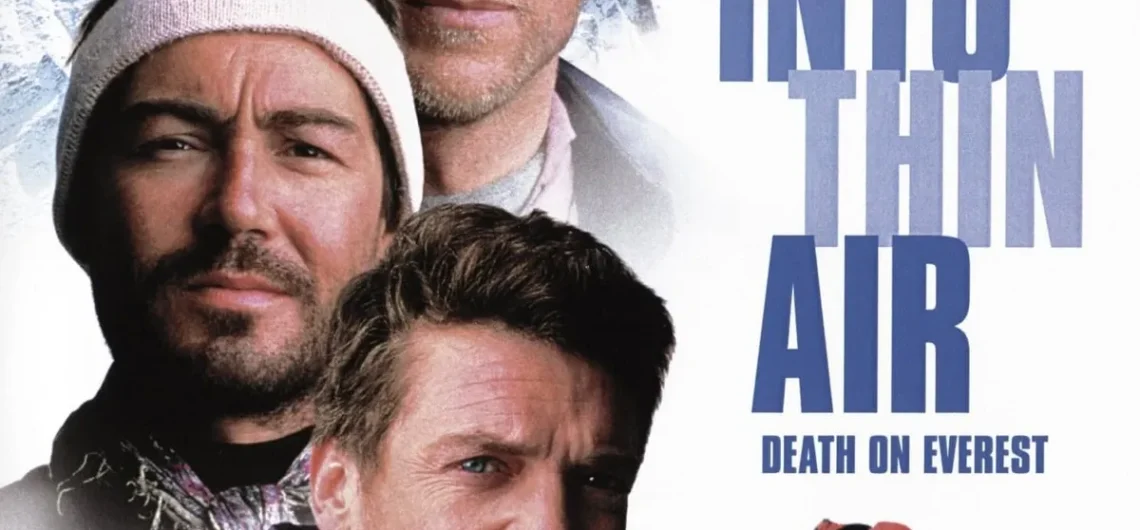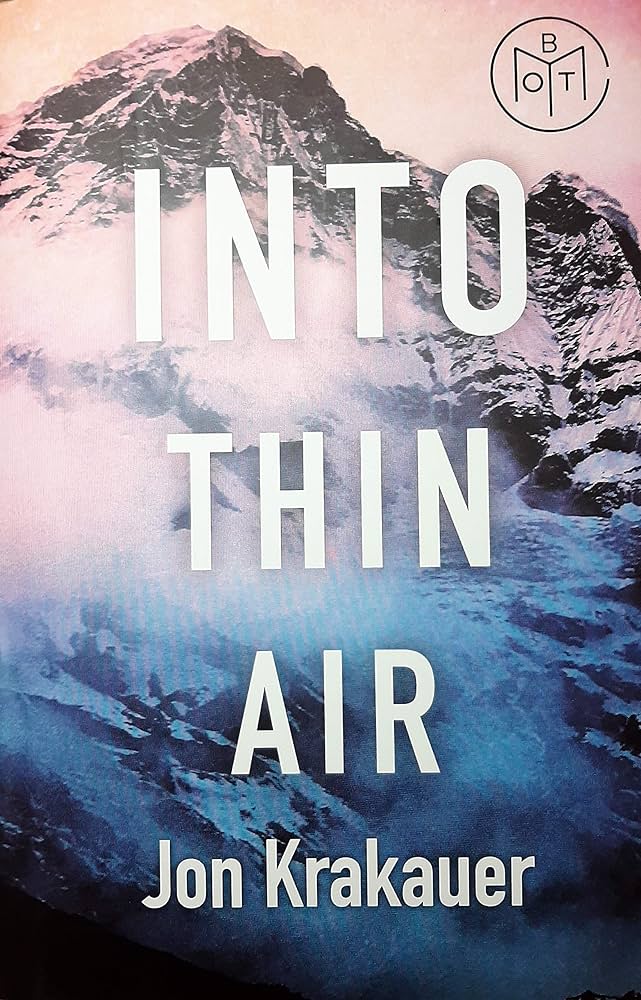Before Into Thin Air, movie was incubated, “Into Thin Air: A Personal Account of the Mt. Everest Disaster” is the main inspiration behind the movie by Jon Krakauer is a popular book that tells the story of the tragic 1996 Mount Everest disaster. Eight climbers died and several others were stranded due to a fierce storm. At the time, Krakauer was part of the expedition led by Rob Hall. The quest for the summit that day was not just their group; Scott Fischer’s agency, Mountain Madness, was competing with Adventure Consultants. Krakauer, a writer and mountain climber, was originally hired to report on the commercialization of Mount Everest for Outside Magazine. Intrigued, he decided to join the Adventure Consultants’ group led by Rob Hall. The book describes the organized ascent from Base Camp up to Camp Four. The author details his teammates, the guides, and other groups on the mountain, attempting to create a comprehensive timeline of their weeks on the mountain. The challenges of high altitude were felt differently by each climber, from weight loss to exhaustion. Regardless of several obstacles, the real tragedy does not occur until Chapter 11. As the climbers make their push to reach the summit, conditions begin to deteriorate. The storm hits while some climbers struggle to reach the top. There are failures in leadership, rescue attempts, and seven climbers perished. Krakauer, initially there to report on the commercialization of the climb, feels compelled to tell the full story, even if it causes pain for the victims’ friends and families. He spends time reflecting on how the events changed his life, and examines the unanswered questions. Ultimately, Krakauer feels it is necessary to share the events thoroughly and accurately.
Into Thin Air – The Book
Krakauer details the events that led to his decision to join an Everest expedition in May 1996, despite having stopped mountain climbing years prior. At the beginning, his plan to climb Everest was purely professional, with the intention to climb only as far as the mountain’s base camp and report on the commercialization of the mountain. However, this rekindled his childhood desire to climb the mountain, and he asked to put off the story’s publication for a year so he could train. The book then shifts between describing events on the mountain and the tragedy that happens during the push to the summit. Krakauer concludes that safety methods on Everest had been compromised by the competition between guiding agencies. His account received criticism from both participants and fellow mountaineers, such as Galen Rowell. Boukreev also provided a rebuttal in his 1997 book, “The Climb”. Krakauer later addressed some of the criticisms in a detailed postscript in the 1999 paperback edition of “Into Thin Air”.
Film Adaptation
Sony acquired the film rights to “Into Thin Air” right after it was published. The book was then made into a television movie called “Into Thin Air: Death on Everest” in 1997, with Peter Horton playing Scott Fischer and Christopher McDonald playing Krakauer. Both the book and the film share a strong editorial perspective on the main causes of the tragedy. However, there are notable differences between the two regarding the details of responsibility. In 2015, director Baltasar Kormákur released the film “Everest,” which depicts the same events as the book. Michael Kelly portrays Krakauer in this film. Kormákur has clarified that his film is not based on Krakauer’s book.
Into Thin Air – The Movie (Death on Everest)
Into Thin Air: Death on Everest is a 1997 telefilm that chronicles the tragic events of the 1996 Mount Everest disaster, as depicted in Jon Krakauer’s memoir, also titled Into Thin Air. The film was directed by Robert Markowitz and written by Robert J. Avrech. Originally aired on ABC on November 9, 1997, it follows summit guides Rob Hall and Scott Fischer as they discuss their plans to reach the summit with their respective clients. Hall’s group includes individuals like Doug Hansen, a mailman from Seattle, Jon Krakauer, Yasuko Namba, and others. Meanwhile, Fischer’s group features Sandy Pittman, a seasoned climber and socialite from New York. As the groups progress through Camps 2, 3, and 4, they embark on their ascent to the summit. Along the way, Fischer is compelled to descend the entire way back to offer aid to a sick client named Dale Cruz. Despite exhaustion, Fischer stubbornly refuses assistance and returns to camp fatigued and gasping for breath.
Both groups steadily make their way down to the Hillary step, a crucial section of the climb. To their surprise, they find that there are no fixed ropes available. One of the Sherpas explains that it is typically a two-person task to install the ropes, but the other Sherpa who was supposed to assist is absent, exhausted from hauling Pittman and her heavy equipment up the mountain. Anatoli Boukreev and Neil Beidelman, guides from Mountain Madness, take charge and begin setting the fixed ropes. As more climbers arrive at the step, congestion builds up at the bottom. Krakauer continues his ascent with Boukreev, eventually being joined by Andy Harris, a guide from Adventure Consultants. After reaching the summit, Krakauer starts his descent and realizes that the crowding at the step has become even worse, leaving him no choice but to wait. Meanwhile, Hall tries to convince Hansen to turn back, but Hansen insists on pushing forward, as he was unable to reach the summit the previous year and cannot afford to fail again. After a heated argument, Hall reluctantly agrees to continue, disregarding his planned turnaround time of 2 p.m. Once the congestion at the step clears, Harris begins descending. However, Krakauer, due to lack of oxygen, starts experiencing hallucinations, which are further exacerbated when Harris mistakenly increases his oxygen flow instead of decreasing it as requested. In a near-fatal incident, Krakauer almost slips over the edge of a precipice, managing to save himself at the last moment. He eventually reaches Harris, only to discover that something is terribly wrong. Harris is convinced that the full oxygen bottles at the oxygen drop are empty. Along his descent, Krakauer encounters Hansen and Hall once again, taking note of approaching storm clouds in the valley and on the mountain. Shortly after 3 p.m., most members of Hall’s and Fischer’s groups successfully reach the summit.
Krakauer proceeds with his journey downwards and encounters Fischer, who is extremely fatigued and adamant about not turning back. After 4 o’clock, Hall and Hansen successfully reach the summit and Hall senses an approaching storm. As the weather deteriorates, Krakauer discovers Weathers sitting alone in the snow. Weathers had undergone eye surgery prior to the expedition and lost his vision during the ascent. Despite Krakauer’s offer to leave together, Weathers declines, as he has made a promise to Rob Hall to wait for him. At 4:30, Fischer and Sherpa Lopsang finally reach the summit, but Fischer collapses immediately. Krakauer reaches Camp 4 and settles down for some rest. Beidelman, Mike Groom, and most of the other climbers pause to take a break. They encounter Weathers, who agrees to descend with them. Unfortunately, the guides become disoriented due to storm clouds and heavy snowfall. Higher up on the mountain, Hall and Hansen struggle to drag Fischer, who lacks the strength to stand on his own. As night falls, Krakauer is awakened in his tent by Ang dorjee, Hall’s Sherpa, who informs him that Hall and the majority of the climbers have not returned. They search for them, but the hazardous conditions make it impossible to continue. Hall attempts to persuade Hansen to stand up and continue descending, but Hansen pleads with him to leave. Refusing to abandon Hansen, Hall insists that they stay together. Meanwhile, Fischer, suffering from oedema, unintentionally veers off the side of the mountain. Lopsang manages to save him by pulling him back up using the short rope that connects them. Fischer becomes increasingly unconscious and Lopsang calls for assistance through the radio.
Hall, who is struggling to deal with the delusional Hansen, loses his footing and tumbles to the ground. The two climbers are then separated, with Hall helplessly witnessing Hansen’s fatal fall. Harris locates Hall and attempts to assist him in getting back on his feet before heading off to seek help, despite Hall’s desperate pleas. As Harris disappears from his sight, he lets out a cry. With great effort, Hall crawls towards the source of the sound, only to discover Harris’s hat lying near a steep drop, leading him to assume that Harris has also met his demise. Buried beneath a blanket of snow, Hall manages to obtain directions from Krakauer to a nearby oxygen supply. However, as he tries to navigate towards it, he unknowingly bypasses the oxygen bottles. Meanwhile, Beidelman and Groom’s group becomes hopelessly disoriented. The guides decide to accompany only the clients who can keep up with them, leaving Namba, Weathers, Pittman, and Charlotte Fox behind. Fischer drifts in and out of consciousness, during which he murmurs the words “I am invincible” to Lopsang. Boukreev successfully assists Fox and Pittman in descending the mountain but is unable to save a third client. Hall experiences hallucinations, briefly seeing Jan before snapping out of it. His hands and legs have succumbed to frostbite, making movement incredibly challenging. He loses consciousness once again. The following morning, Hall awakens, barely clinging to life. He manages to communicate with Jan through a radio at the camp. The couple decides to name their unborn daughter Sarah. After bidding a sorrowful farewell to his wife, Hall succumbs to hypothermia and passes away. Weathers regains consciousness, having miraculously survived being buried under the snow without access to oxygen. Despite his vision impairment, he somehow finds his way back to camp and receives assistance. Boukreev makes the arduous climb up, discovering Fischer’s frozen body. He pays his respects, covers Fischer’s face, and departs. At base camp, the remaining survivors reflect on the friends they have tragically lost.
Into Thin Air: Death on Everest (1997 TV Movie)
IMDb Rating: 5.7/10
Duration: 1h 30m
Rating: TV-14
Synopsis: A dramatization of the disastrous 1996 Mount Everest expeditions.
Director: Robert Markowitz
Writer: Robert J. Avrech
Into Thin Air Cast:
- Christopher McDonald as Jon Krakauer
- Peter Horton as Scott Fischer
- Nathaniel Parker as Rob Hall
- Richard Jenkins as Beck Weathers
- Tim Dutton as Andy Harris
- Jeff Perry as Doug Hansen
- Akemi Otani as Yasuko Namba
- Peter J. Lucas as Anatoli Boukreev
- Luke Garrett as Michael Groom
- Ned Vaughn as Neal Beidleman
- Long Nguyen as Ang Dorj
- Romilly Weeks as Charlotte Fox
- Pamela Gein as Sandy Hill Pittman
- Richard Rees as Lopsang
- Nicholas Hewetson as Tim Madsen
- Everest 2015 – The Movie
- Top 8 movies about Mount Kilimanjaro that will inspire you to climb.
- Real life lessons from Walt Disney’s Lion King Adventure Movie that features Mount Kilimanjaro
- Actress Deeya conquers Everest and Kilimanjaro
- Nirmal Nims Purja MBE, a.k.a Nimsdai, King of the mountains and EliteExped
- (Recap) Kilimanjaro: To the roof of Africa film by IMAX
- David Breashears, 68, who transmitted the first live pictures from the summit of Mount Everest in 1983, Dies
- How brave Neal Beidleman made decisions to save lives on Everest
- Best camera brands to bring on your Kilimanjaro trek
- Tanzanian President to launch the much awaited Royal Tour film in Arusha and Zanzibar
- Remembering Julie Tullis, world’s first female high-altitude mountaineering filmmaker
![]()



Comments